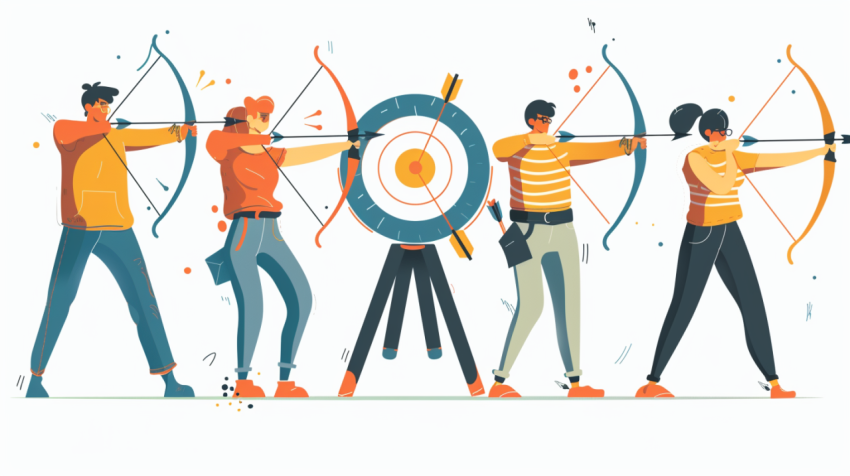











Capturing the Spirit of Competition and Global Unity Through Art
Olympic Games illustration is a specialized field of art that visually represents the spirit, excitement, and global unity of the Olympic Games. From iconic posters to playful mascots, these illustrations play a crucial role in promoting the Games, celebrating athletic achievement, and conveying the values of sportsmanship, fair play, and international cooperation. Olympic Games illustrations often become enduring symbols of the Games, capturing the essence of each Olympiad and leaving a lasting visual legacy.
1. The History of Olympic Games Illustration: A Visual Record of the Games
The use of visual imagery to represent the Olympic Games dates back to the early modern Games:
- Early Olympic Posters: The first official Olympic poster was created for the 1912 Stockholm Games. Early posters often featured classical imagery, allegorical figures, and depictions of athletic events.
- The Rise of Modern Design: Over time, Olympic posters evolved to reflect contemporary art and design trends, embracing modernism, abstraction, and graphic design principles.
- Iconic Posters: Certain Olympic posters have become iconic, such as the posters for the 1972 Munich Games designed by Otl Aicher, which featured a minimalist and highly influential design system.
- Mascot Design: The first official Olympic mascot, Waldi the dachshund, was introduced at the 1972 Munich Games. Since then, mascots have become a popular and enduring feature of the Olympics, representing the host city or country and appealing to a wide audience, especially children.
2. The Purpose of Olympic Games Illustration: Promoting and Celebrating the Games
Olympic Games illustrations serve several key purposes:
- Promotion and Marketing: Posters, logos, and other visual materials are used to promote the Games and generate excitement among spectators and participants.
- Visual Identity: A strong visual identity helps to create a cohesive and memorable brand for each Olympic Games.
- Cultural Representation: Illustrations often incorporate elements of the host city or country's culture, history, and artistic traditions.
- Celebrating Athleticism: Illustrations depict athletes in action, showcasing the skill, dedication, and physical prowess of Olympic competitors.
- Promoting Olympic Values: Illustrations can convey the Olympic values of excellence, friendship, respect, and fair play.
- Commemoration: Olympic posters and other illustrations serve as lasting visual records of the Games, capturing the spirit of each Olympiad.
3. Types of Olympic Games Illustration: Posters, Mascots, and More
Olympic Games illustration encompasses a variety of forms:
- Olympic Posters: Perhaps the most iconic form of Olympic illustration, posters are used to promote the Games and often become collector's items.
- Olympic Mascots: Playful characters, often animals or mythical creatures, that represent the host city or country and embody the spirit of the Games.
- Olympic Logos: The official emblem of each Olympic Games, used on a wide range of materials, from merchandise to signage.
- Pictograms: Stylized symbols that represent each Olympic sport, used for signage, tickets, and other informational materials.
- Opening and Closing Ceremony Design: Illustrations and design concepts are used in developing themes for these ceremonies.
- Merchandise Design: Illustrations are featured on a wide range of Olympic merchandise, including apparel, souvenirs, and collectibles.
4. Styles of Olympic Games Illustration: Reflecting Artistic Trends
The style of Olympic Games illustration has evolved over time, reflecting broader trends in art and design:
- Early 20th Century: Posters often featured classical or Art Nouveau influences.
- Mid-20th Century: Modernist and abstract styles became more prevalent.
- Late 20th and Early 21st Centuries: A wide range of styles have been used, including graphic design, photography, and digital illustration.
- Contemporary: Often reflects the culture of the host nation or city.
5. The Design Process: Creating a Visual Identity for the Games
Creating the visual identity for an Olympic Games is a complex and collaborative process:
- Theme Development: A theme is often chosen for each Games, providing a unifying concept for the visual identity.
- Design Brief: A detailed brief is developed, outlining the objectives, target audience, and key messages for the visual identity.
- Concept Development: Designers and illustrators create a range of concepts and sketches.
- Selection and Refinement: The best concepts are selected and refined, often with input from the International Olympic Committee (IOC) and the local organizing committee.
- Implementation: The final designs are implemented across a wide range of applications, from posters and logos to signage, merchandise, and digital platforms.
6. Notable Olympic Games Illustrators and Designers:
- Otl Aicher (1972 Munich Games): Created a highly influential design system based on a grid, using bright colors and minimalist pictograms.
- Lance Wyman (1968 Mexico City Games): Designed the iconic logo and graphic identity, drawing inspiration from Mexican folk art.
- Susan Kare (1984 Los Angeles): Designed some early computer icons for Apple, and contributed to the design of the 1984 Olympic pictograms.
7. The Cultural Impact of Olympic Games Illustration
Olympic Games illustrations have a significant cultural impact:
- They contribute to the overall atmosphere and excitement of the Games.
- They help to create a sense of shared identity among spectators and participants from around the world.
- They often reflect the cultural values and artistic traditions of the host city or country.
- They can become iconic symbols of the Olympic movement and its ideals.
8. The Future of Olympic Games Illustration
- Olympic Games illustration will likely continue to evolve, embracing new technologies and design trends.
- Digital illustration, animation, and interactive media are likely to play an increasingly important role.
- Sustainability and environmental concerns may also influence the design and production of Olympic visuals.
Conclusion:
Olympic Games illustration is a dynamic and multifaceted field that plays a crucial role in shaping the visual identity and cultural impact of the Olympic Games. From iconic posters to playful mascots, these illustrations capture the spirit of athletic competition, international unity, and the enduring values of the Olympic movement. As the Games continue to evolve, Olympic Games illustration will undoubtedly continue to adapt, reflecting new technologies, design trends, and the ever-changing global landscape.
Olympic Games illustration, Olympic Games art, Olympic posters, Olympic mascots, Olympic logos, Olympic pictograms, Olympic design, Olympic branding, history of Olympic posters, history of Olympic mascots, Olympic Games art styles, Olympic Games illustration techniques, famous Olympic posters, famous Olympic mascots, Otl Aicher, Lance Wyman, 1972 Munich Games design, 1968 Mexico City Games design, Olympic Games illustration inspiration, Olympic Games illustration for sale, Olympic Games illustration jobs, Olympic Games illustration commission, Olympic Games art prints, Olympic Games merchandise design, Olympic Games graphic design, Olympics, Summer Olympics, Winter Olympics, International Olympic Committee (IOC), sports illustration, sports art.

